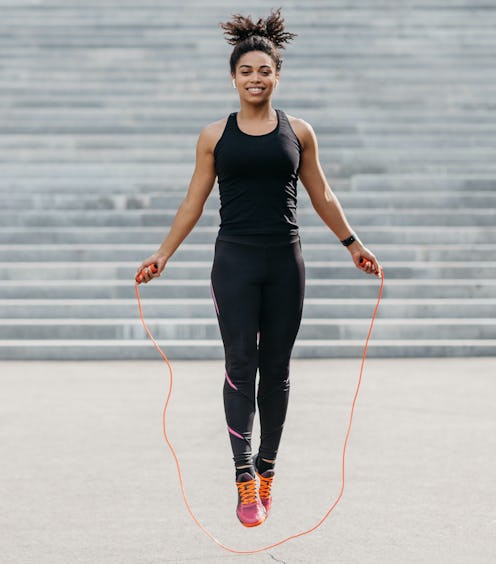The $10 Workout Kaley Cuoco & Halle Berry Swear By
Jump for joy!

As the weather gets cooler, it may be hard to motivate yourself to get out of bed and head to the gym. Plus, considering the events of the past 18 months, you may have already gotten used to working out at home. And just when you thought you had your fitness routine down to a yoga-Peloton-outdoor-run science, a jump rope workout comes into view. Yes, you heard that right. It’s the perfect — and affordable — fall exercise you didn’t even know you needed. Not only is it cost-effective, but jumping rope provides an amazing cardio effect, too. It’ll help strengthen your bones and overall body composition. Fun fact: Naomi Campbell, Halle Berry, and Kaley Cuoco are fans, too.
Plus, this type of workout is good for heart health, says the American Heart Association, which also recommends getting at least 150 minutes of moderate-intensity aerobic activity per week or 75 minutes of vigorous aerobic activity (or a nice mix of both!). Dr. Vivek Cherian, an internal medicine physician at Amita Health, an affiliate of Ascension, agrees. “At minimum, jump roping qualifies as a moderate aerobic exercise,” he says. “Depending on your intensity, it can [even] be a vigorous aerobic exercise.”
In addition to boosting your immune system, energy, and brain health, jump rope sessions can also do good for both your sleep and mental wellness. “Most people have varying degrees of stress in their lives, and routine exercise releases hormones, such as dopamine, which helps improve your overall mood and helps fight against depression,” says Dr. Cherian.
Jump Rope 101
The Jump Rope Coach Chris, CEO of The Jump Rope Company Ltd., says rope rookies can start by jumping for just 30 seconds. (Hint: Music helps.) “It's important to note that everyone's bodies are different,” he tells TZR in an email. “For most, I recommend starting out with just a couple minutes a day (five to 10 at most), and then progressively increasing the lengths of sessions is key to preventing shin splints. It's essential to listen to your body, keep hydrated, and stretch.”
But, regardless of someone’s pre-existing fitness levels, beginners should start by simply learning how to control their rope, even before they start jumping, he says. “Different ropes have different purposes, just like different golf clubs or different tires on a bike do.”
For beginners, he recommends a one-inch beaded jump rope. “This rope comprises a nylon cord with shatterproof segmented beads threaded onto it,” he says. “The rope is slightly heavier and slower than more widely known plastic cord ropes, but this aids in helping the new jumper develop a better understanding of how the rope moves around them, significantly improving progress in the early stages.”
Thirty-time Grand World Jump Rope Champion & World Record Holder Tori Boggs has jumped rope for more than 20 years. She, too, recommends a beaded or plastic jump rope and says they’re easily adjustable. “These ropes are great for sensory feedback: You can see the rope travel through the air, hear it hit the ground or ‘whoosh’ by your ear, and feel the weight of the rope,” she says. “It also helps to start with proper sizing, which is unique to the technique of the jumper. Often, people make [jump roping] mistakes because the rope is too long or too short. Then they may get frustrated and stop altogether when it really wasn’t because they were doing anything incorrectly — the rope just wasn’t the best size for them.”
To test how your rope “fits,” she recommends holding the handles in each hand, standing on the rope with both feet, and pulling up on the handles. “They should come up to somewhere between the bottom of your ribcage and chest,” she says. “This sweet spot allows for a bit of leeway when it comes to changing your technique while learning.”
Boggs says there are many tutorials online (including on her social channels, like Instagram, @snorib) and, for those adopting the sport, also recommends joining jump rope meet-ups or the International Jump Rope Union (IJRU). Jump Rope Coach Chris also has a free jump roping course for beginners, “The Entry 20.”
Perfecting Your Jump Rope Workout
“Jumping rope is accessible, portable, and inexpensive — only a small space and a $10 piece of equipment are required,” says Boggs. “You can pretty much jump rope anywhere (at least my goal is to show people that).”
Jump Rope Coach Chris says competitions are always held indoors on wooden gymnasium floors and they are “the holy grail of jump rope surfaces.” But you can jump anyplace there is a flat, smooth surface, he says, although he’d avoid grass, sloping, or uneven floors. “Concrete is the most likely outdoor surface you'll want to use, but a thin vinyl yoga mat might be advisable to help soften the impact of jumping,” he says. “If jumping indoors, carpet is not recommended, so a mat is advisable here, too.”
Boggs says she has yet to get bored with jumping rope. “There are constantly new ways to challenge yourself and connect with others,” she adds. “I never could have imagined the incredible global opportunities that have come from a simple jump rope and showing people what they never before knew was possible.”
She adds that while jump roping is not easy, it is fun. “Develop great building blocks in the beginning and then start to create and develop your own style of jumping and moving,” she says. “This will be when the real fun and creativity begin and you’ll be hooked for life.”
We only include products that have been independently selected by TZR's editorial team. However, we may receive a portion of sales if you purchase a product through a link in this article.